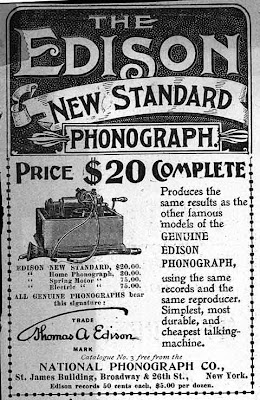History of the Sound very rare sounds collection…The History of the Edison Cylinder Phonograph…The phonograph was developed as a result of Thomas Edison’s work on two other inventions, the telegraph and the telephone. In 1877, Edison was working on a machine that would transcribe telegraphic messages through indentations on paper tape, which could later be sent over the telegraph repeatedly. This development led Edison to speculate that a telephone message could also be recorded in a similar fashion. He experimented with a diaphragm which had an embossing point and was held against rapidly-moving paraffin paper. The speaking vibrations made indentations in the paper. Edison later changed the paper to a metal cylinder with tin foil wrapped around it. The machine had two diaphragm-and-needle units, one for recording, and one for playback. When one would speak into a mouthpiece, the sound vibrations would be indented onto the cylinder by the recording needle in a vertical (or hill and dale) groove pattern. Edison gave a sketch of the machine to his mechanic, John Kruesi, to build, which Kruesi supposedly did within 30 hours. Edison immediately tested the machine by speaking the nursery rhyme into the mouthpiece, “Mary had a little lamb.” To his amazement, the machine played his words back to him.
Although it was later stated that the date for this event was on August 12, 1877, some historians believe that it probably happened several months later, since Edison did not file for a patent until December 24, 1877. Also, the diary of one of Edison’s aides, Charles Batchelor, seems to confirm that the phonograph was not constructed until December 4, and finished two days later. The patent on the phonograph was issued on February 19, 1878. The invention was highly original. The only other recorded evidence of such an invention was in a paper by French scientist Charles Cros, written on April 18, 1877. There were some differences, however, between the two men’s ideas, and Cros’s work remained only a theory, since he did not produce a working model of it.
Original Edison Tin Foil Phonograph. Photo courtesy of U.S. Department of the Interior, National Park Service, Edison National Historic Site.
See Caption Below
Edison took his new invention to the offices of Scientific American in New York City and showed it to staff there. As the December 22, 1877, issue reported, “Mr. Thomas A. Edison recently came into this office, placed a little machine on our desk, turned a crank, and the machine inquired as to our health, asked how we liked the phonograph, informed us that it was very well, and bid us a cordial good night.” Interest was great, and the invention was reported in several New York newspapers, and later in other American newspapers and magazines.

The Edison Speaking Phonograph Company was established on January 24, 1878, to exploit the new machine by exhibiting it. Edison received $10,000 for the manufacturing and sales rights and 20% of the profits. As a novelty, the machine was an instant success, but was difficult to operate except by experts, and the tin foil would last for only a few playings.
Ever practical and visionary, Edison offered the following possible future uses for the phonograph in North American Review in June 1878:
1. Letter writing and all kinds of dictation without the aid of a stenographer.
2. Phonographic books, which will speak to blind people without effort on their part.
3. The teaching of elocution.
4. Reproduction of music.
5. The “Family Record”–a registry of sayings, reminiscences, etc., by members of a family in their own voices, and of the last words of dying persons.
6. Music-boxes and toys.
7. Clocks that should announce in articulate speech the time for going home, going to meals, etc.
8. The preservation of languages by exact reproduction of the manner of pronouncing.
9. Educational purposes; such as preserving the explanantions made by a teacher, so that the pupil can refer to them at any moment, and spelling or other lessons placed upon the phonograph for convenience in committing to memory.
10. Connection with the telephone, so as to make that instrument an auxiliary in the transmission of permanent and invaluable records, instead of being the recipient of momentary and fleeting communication.
Eventually, the novelty of the invention wore off for the public, and Edison did no further work on the phonograph for a while, concentrating instead on inventing the incadescent light bulb.
In the void left by Edison, others moved forward to improve the phonograph. In 1880, Alexander Graham Bell won the Volta Prize of $10,000 from the French government for his invention of the telephone. Bell used his winnings to set up a laboratory to further electrical and acoustical research, working with his cousin Chichester A. Bell, a chemical engineer, and Charles Sumner Tainter, a scientist and instrument maker. They made some improvements on Edison’s invention, chiefly by using wax in the place of tin foil and a floating stylus instead of a rigid needle which would incise, rather than indent, the cylinder. A patent was awarded to C. Bell and Tainter on May 4, 1886. The machine was exhibited to the public as the graphophone. Bell and Tainter had representatives approach Edison to discuss a possible collaboration on the machine, but Edison refused and determined to improve the phonograph himself. At this point, he had succeeded in making the incandescent lamp and could now resume his work on the phonograph. His initial work, though, closely followed the improvements made by Bell and Tainter, especially in its use of wax cylinders, and was called the New Phonograph.
The Edison Phonograph Company was formed on October 8, 1887, to market Edison’s machine. He introduced the Improved Phonograph by May of 1888, shortly followed by the Perfected Phonograph. The first wax cylinders Edison used were white and made of ceresin, beeswax, and stearic wax.

